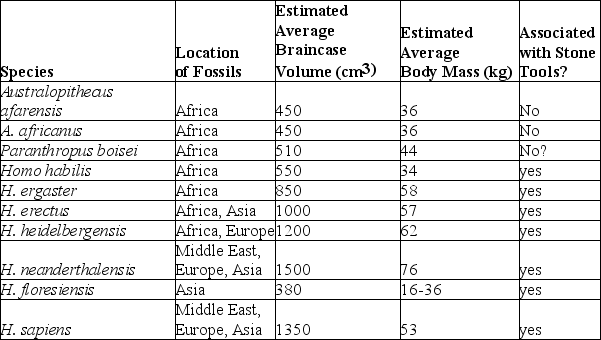Use the following information to answer the question.
Brown et al. and Morwood et al. reported in 2004 that they had found skeletal remains of a previously unknown type of hominin, now dubbed Homo floresiensis, on the Indonesian island of Flores. These hominins were small (approximately 1 meter tall) with small braincases (approximately 380 cubic centimeters) as compared with other hominins. The remains of H. floresiensis were found alongside handmade stone tools and the remains of dwarf elephants that also inhabited the island, suggesting that H. floresiensis was able both to make tools and to coordinate the hunting of animals much larger than itself. H. floresiensis is estimated to have lived at the site where the remains were found from at least 38,000 years ago to 18,000 years ago.
The table is a comparison of several characteristics of H. floresiensis to those of nine other hominin species (arranged roughly from oldest to most recent) . What do these data suggest?
A) A large brain is not necessarily required for toolmaking.
B) Body mass and braincase volume are completely unrelated.
C) Hominins first evolved in and then radiated out from Asia.
D) Homo floresiensis is most closely related to Australopithecus afarensis or A. africanus.
Correct Answer:
Verified
Q46: In what respect do hominins differ from
Q60: Which of the following characteristics occur in
Q61: As hominins diverged from other primates, which
Q63: Which of the following could be considered
Q64: Unlike eutherians, both monotremes and marsupials _.
A)
Q66: Living vertebrates can be divided into two
Q72: With which of the following statements would
Q74: Which of the following statements about human
Q75: On the back of your skull you
Q78: Marsupials survived in Australia (as opposed to
Unlock this Answer For Free Now!
View this answer and more for free by performing one of the following actions

Scan the QR code to install the App and get 2 free unlocks

Unlock quizzes for free by uploading documents